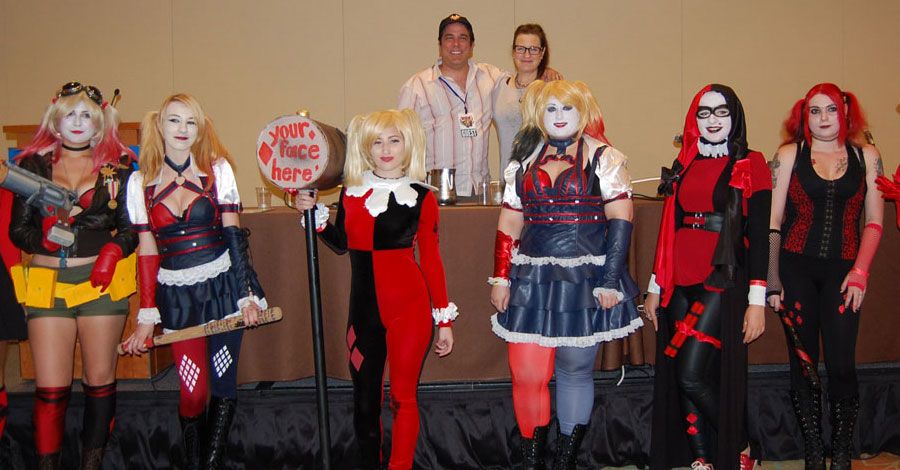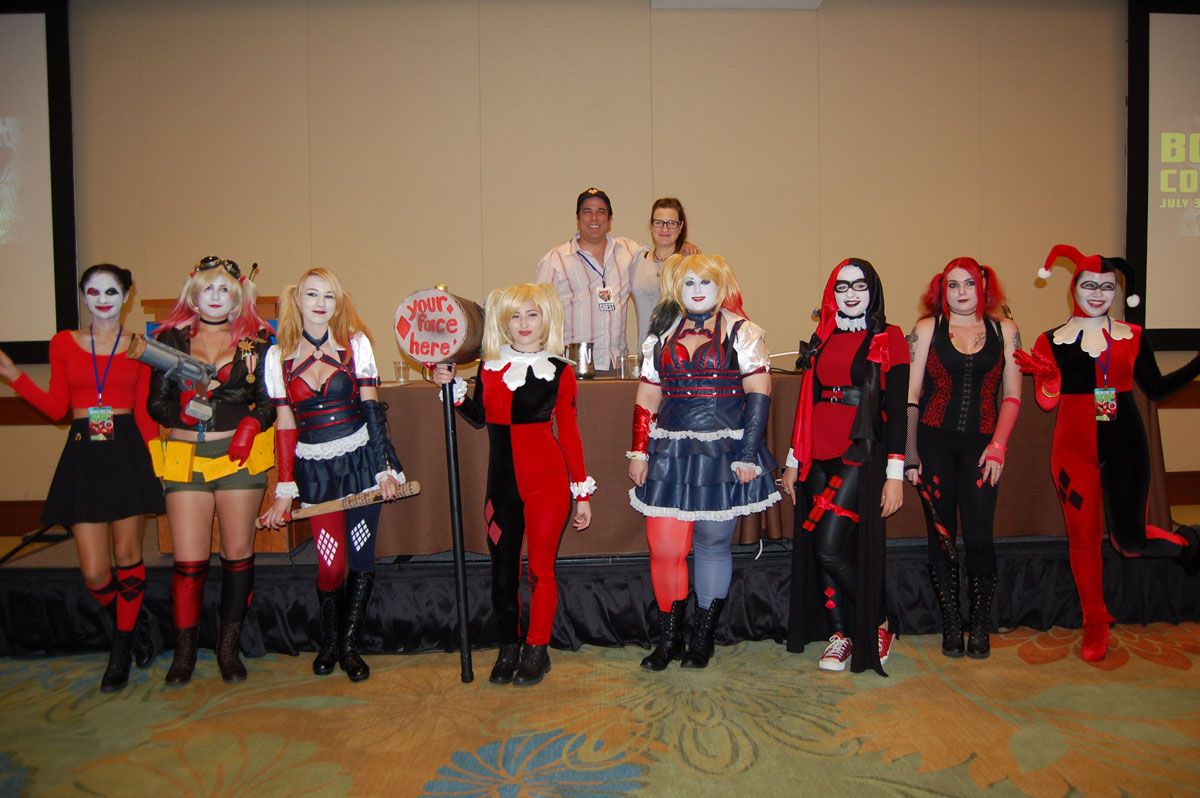Though Jimmy Palmiotti and Amanda Conner's Boston Comic Con panel was well attended, the creators managed to maintain a sense of intimacy during their talk with the audience. The husband-and-wife team, who currently co-write "Harley Quinn," "Harley Quinn and Power Girl" and "Starfire" for DC Comics, chatted and joked as if they were sitting around in their living room, riffing off questions and comments tossed out by fans and ending the panel by taking a group shot with all the Harley Quinn cosplayers in attendance.
The duo began co-writing "Harley Quinn" in 2013, and their lighthearted, over-the-top version of the sometimes-villain has proved popular with readers. "If you hang out with us more today, you'll understand why the book reads like crazy people wrote it," Palmiotti said. "Any idea that pops into our head, it kind of makes it into the next page."
Conner explained Harley's appeal this way: "If you've ever been in traffic and somebody cuts you off and you fantasize about having a missile cannon welded to the front of your car, Harley is the person who will actually weld the missile cannon to the front of her car and use it. Harley is a good way to live out your fantasies."
CBR TV @ SDCC: Conner & Palmiotti Talk "Harley Quinn," "Starfire" & Forging Their Own Path
"Harley Quinn" kicked off with a #0 issue drawn by 19 different artists, one for each page, including Bruce Timm, one of the character's creators. Palmiotti said the idea came to him in a dream. "I actually woke up in San Diego and I said, 'What if we had a different artist on every page?' which is an editor's nightmare. And what we did is, we wrote just little brief descriptions, and [DC Comics co-publisher] Dan DiDio said, 'If you can get 19 artists by the time you leave San Diego to commit to this, we'll do it.'"
"The joke was that other than the bookended stuff, where she's in the locker and falls asleep and dreams this thing, there was no continuity," Palmiotti said. "So we got the pages, and then we dialogued them. We just flipped them around and put them in a weird order."
"We gave each artist a rough idea of what we were looking for on the page, and then Darwyn Cooke totally ignored his and did his own thing," Conner added.
"Actually, a lot of people ignored what we gave them and drew whatever they wanted," Palmiotti said. "We had 18 pages of stuff, and we had to make it come together and seem like there was an actual story, and that was how we wrote it. It was a very difficult thing to do, but it looked effortless when it was on the page. When that sold very well, DC was like, 'OK, you guys keep doing the regular series.' Nobody expected this book to sell, by the way. They said, 'Oh it will sell OK.' Honestly, I have a good reputation of destroying books, so we didn't didn't really think it was going to sell that much, and then we surprised everybody. It's actually you guys that surprised everybody, it's not us."
"We just wrote it," Conner said. "You guys made it work."
"Starfire" was a different matter. When Palmiotti and Conner started the series, fans had been vocal in their dislike of the more sexualized version of the character that had appeared most recently in "Red Hood and the Outlaws." "I grew up reading the Marv Wolfman-George Perez 'Teen Titans' [where Starfire first appeared]," Conner said, drawing applause from the audience. "We were trying to steer her back towards that personality."
Conner expanded on that point later in the panel. "We take what we like about classic Starfire, 'Teen Titans Go!' Starfire, and then put our own situations into it. This is how we write: [Jimmy] sort of builds the house and frames it out, and I paint and decorate it with dialogue and some excess scenery and stuff like that."
Palmiotti and Conner decided to set the book in Key West for both logical and personal reasons. "We have been there many times," Palmiotti said. "We know how people are down there -- a little more laid back, a little more open to things. They won't mind an orange girl so much; they'll just think it's bad suntan lotion or something. The idea is that she might blend in a little better in a different location.... We put her around water, we put her around people in bathing suits, so it won't be so bad when she is running around half naked, but it doesn't have to be a sexual thing."
The pair also talked about how they like to keep Harley in her own little world, rather than having her participate in the greater DCU. "I'm not a big lover of event books," Palmiotti said. "For me, if it's an event and everything just goes back to normal, I don't like it. I want the event to mean something. So part of why Harley and Starfire don't mix it up with [the Justice League of America] is, if we do that, then we have to acknowledge everything that's going on in the other books, and that will change our story somewhat."
"I love the smaller stories," Conner said.
"I'd rather have a whole issue of Harley finding out where her mail went," Palmiotti said. "That would be, for me, a great Harley story. She starts harassing people, she accuses somebody who didn't do it and she shoots someone else --"
"And meanwhile, Batman and Superman are saving the universe, and she's looking for her mail --" Conner said.
"And then she gets her mail, and it's all flyers," Palmiotti said as the audience laughed. "To me, that's a more attractive thing to write. I always say, understand what you don't do very well, and understand what you do, and try to work on that a little bit."
Of course, that doesn't mean other DC characters are totally off limits for their ideas. "We missed doing the Power Girl books so much, we thought it was a great idea to put Power Girl in ['Harley Quinn']," Conner said. "It turned out to do really well, and Jimmy finagled it so that if they gave us the go-ahead, we could do a Power Girl/Harley miniseries."
The miniseries is based on two panels of Power Girl's 2014 guest appearance in "Harley Quinn," when the character jumps out of one time-space continuum into another. "I took the six issues and said, 'That's what happened between the two panels,'" Palmiotti said. "We pitched it to Dan DiDio and he was like, 'Yeah, sure, why not? Go ahead.'"
"The other great thing about having a book that sells really well is, they let you do stuff," Palmiotti said. "Look, we had the only comic that you could scratch and sniff. Think about how ridiculous that is -- and it was even harder to write, by the way, because it's not like we got to pick where the smells went. They tell us where, and we had to write around it, where they would actually land."
"Writing around the smells," Conner said. "We had to shoehorn the story around the smells."
Responding to a question about creating comics, Palmiotti put his own spin on the old saw about writing what you know. "You need a lot of experiences," he said. "Sure, these are characters we make up, and sure there are things that happen, but there is a reality to everything you write, in a way, and Harley's a good book in that way. In one of the issues, we have one of the Gang of Harleys, the quintuplets from Staten Island, their mother comes after them and chases them with a wooden spoon. They are an Italian family, and the mother chases them with a wooden spoon. Anyone that has an Italian family understands that mom's only weapon was a wooden spoon... There were 4 boys in my house, and my mom was constantly chasing us with a spoon!
"Anyway, there is a scene in 'Harley' where the mom doesn't like that her daughters are involved with this, and we have Eggy, the character which is a giant egghead, and he comes out and he has a crack in his head and he's just yelling 'The spoon, the spoon,' and then the next thing, you see the mom coming up with the spoon, 'Where are my daughters?' That's very much real life for me. Part of your life, the stuff you go through, the stuff that you grew up with, you try to work it into your work as a writer, and I think sometimes that really makes the book. I don't know what it's like to be Harley Quinn, but I know what it's like to be upset when something doesn't go my way."


